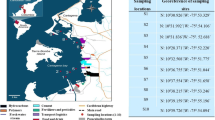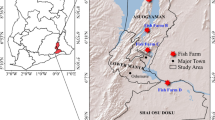Abstract
Persistent organic pollutants (POPs) were found in bottom sediments and muscles of a freshwater fish, bream (Abramis brama L.), from the Rybinsk Reservoir. The contents of POPs decreased in the following order: PCBs > DDT > HCH > HCB. The POPs contents vary within the ranges of 0.14–50.8, 1.8–6.8, 0.64–2.6, and 0.06–0.41 \gmg/kg wet weight for fish and 24.8–425.6, 2.3–27.1, and 0.34–0.83 fug/kg dry weight for bottom sediments (except for HCH), respectively. The highest and lowest POPs levels were found in the Sheksna and the Mologa reaches of the reservoir, respectively. The differences in the spatial distribution of POPs in the reservoir relate to the ways that contaminants enter and migrate in the waterbody but not to various compositions of bottom sediments. The waste waters of the city of Cherepovets are the main local source of POPs in the Sheksna reach of the reservoir; in the Mologa reach, the contaminants enter with surface runoff and through global transboundary and local atmospheric transports from the Cherepovets industry. The qualitative composition of POPs evidences their continuing income to the reservoir. Considering the revealed levels of POPs accumulation and their legislative safe environment levels, it should be concluded that PCBs represent the highest environmental threat to the reservoir’s ecosystem.
Similar content being viewed by others
References
Arinushkina, E.V., Rukovodstvo po khimicheskomu analizu pochv (Chimical Analysis of Soil: A Manual), Moscow: Mosk. Gos. Univ., 1961.
Braginskii, L.P., Komarovskii, F.Ya., and Merezhko, A.I., Persistentnye pestitsidy v ekologii presnykh vod (Persistent Pesticides in Freshwater Ecology), Kiev: Naukova Dumka, 1979.
Butorin, N.V., Ziminova, N.A., and Kurdin, V.P., Don-nye otlozheniya verkhnevolzhskikh vodokhranilishch (Benthic Sediments in Upper-Volga Reservoirs), Leningrad: Nauka, 1975.
German, A.V. and Zakonnov, V.V., Accumulation of Polychlorinated Biphenyls in the Sheksninskii Pool of the Rybinsk Reservoir, Vodn. Resur., 2003, vol. 30, no. 5, pp. 571–575 [Water Resour. (Engl. Transl.), 2003, vol. 30, no. 5, pp. 524–528].
German, A.V. and Kozlovskaya, V.I., The Content of Polychlorinated Biphenyls in the Bream (Abramis brama) in the Rybinsk Reservoir, Vopr. Ikhtiol., 1999, vol. 39, no. 1, pp. 139–142.
Gigienicheskie normativy soderzhaniya pestitsidov v ob”ektakh okruzhayushchei sredy (perechen’). Dopolne-nie no. 1 kGN 1.1.1109-02 (Sanitary Standards for Pesticide Content in Environmental Objects (Checklist). Appendix no. 1 to GN 1.1.1109-02), Moscow: Feder. Tsentr Gossanepidnadzora Minzdrava RF, 2002, p. 77.
Zhiteneva, T.S., Characteristics of the Diet of Abramis brama L. in the Gray Mud Biotope in Different Stretches of the Rybinsk Reservoir, in Vnutripopulyat-sionnaya izmenchivost’pitaniya i rosta ryb (Intrapopula-tion Variability in Fish Nutrition and Growth), Yaroslavl: Inst. Biol. Vnutr. Vod AN SSSR, 1981, pp. 53–63.
Klenkin, A.A., Korotkova, L.I., Korpakova, I.G., and Kornienko, G.G., Organochlorine Pesticides and Polychlorobiphenyls in Commercially Important Fishes of the Azov Sea, Vopr. Rybolovstva, 2008, vol. 9, no. 2(34), pp. 495–502.
Klyuev, N.A. and Brodskii, E.S., Determination of Polychlorinated Biphenyls in the Environment and Biota, in Polikhlorirovannye bifenily. Supertoksikanty XXI veka (Polychlorinated Biphenyls: Supertoxicants of the XXI Century), Moscow: VINITI, 2000, no. 5, pp. 31–63.
Kozlovskaya, V.I. and German, A.V., Polychlorinated Biphenyls and Polycyclic Aromatic Hydrocarbons in the Ecosystem of the Rybinsk Reservoir, Vodn. Resur. 1997, vol. 24, no. 5, pp. 563–569 [Water Resour. (Engl. Transl.), 1997, vol. 24, no. 5, pp. 520–526].
Kolpakova, E., Lulof, I., and Ruttemaan, I., Proekt “Volga v Cherepovtse”: Otchet ob issledovaniyakh, provedennykh v g. Cherepovtse v avguste 1995 g (The Volga in Cherepovets Project. Report on Studies Performed in Cherepovets in August 1995), Nizhnii Novgorod: Ekotsentr “Dront”, 1996.
Livanov, G.A., Khudolei, V.V., and Kolbasov, S.E., The Main Sources of Dioxin-Like Compounds Belonging to the Class of Polychlorinated Biphenyls in St. Petersburg and Leningrad Oblast Their Role and Migration Pathways, in Polikhlorirovannye bifenily. Supertoksi-kanty XXI veka (Polychlorinated Biphenyls: Supertoxi-cants of the XXI Century), Moscow: VINITI, 2000, no. 5, pp. 70–86.
Luk’yanova, O.N., Boyarova, M.D., Chernyaev, A.P., et al., Organochlorine Pesticides in Aquatic Ecosystems of the Far East of Russia, Issledovanie i okhrana prirodnykh resursov Rossii (Study and Conservation of Natural Resources of Russia), 2007, no. 2, pp. 31–35.
Maier, F.L., Peti, J.D., Kozlovskaya, V.I., and Flerov, B.A., Determination of Residual Amount of Pesticides in Fishes Inhabiting the Rybinsk Reservoir, Gidrobiol. Zh., 1981, vol. 17, no. 5, pp. 83–87.
Maistrenko, V.N. and Klyuev, N.A., Ekologo-analiticheskii monitoring stoikikh organicheskikh zagryaznitelei (Ecological—Analytical Monitoroing of Stable Organic Pollutants), Moscow: BINOM. Laboratoriya znanii, 2004.
Pavlov, D.F. and Bakin, A.N., Organochlorine Pesticides in Inland Water Bodies of Russia: A Review of Published and Our Own Data, Aktual’nye voprosy vod-noi toksikologii (Relevant Problems of Aquatic Toxicology), Borok: Inst. Biol. Vnutr. Vod RAN, 2004, pp. 150–175.
Parke, D.V., The Biochemistry of Foreign Compounds, Oxford: Pergamon Press, 1967.
Poddubnyi, A.G., Ekologicheskaya topografiya popu-lyatsii ryb v vodokhranilishchakh (Environmental Topography of Fish Populations in Reservoirs), Leningrad: Nauka, 1971.
Poryadin, A.F, Polychlorobiphenyls and Environmental Safety of Russia, in Polikhlorirovannye bifenily. Supertoksikanty XXI veka (Polychlorinated Biphenyls: Supertoxicants of the XXI Century), Moscow: VINITI, 2000, no. 5, pp. 3–4.
Rovinskii, F.Ya., Voronova, L.D., Afanas’ev, M.I., et al., Fonovyi monitoring zagryazneniya ekosistem sushi khlororganicheskimi soedineniyami (Background Monitoring of Pollution of Terrestrial Ecosystems with Organochlorine Compounds), Leningrad: Gidrometeoiz-dat, 1990.
Semenova, V.V., Vorob’eva, L.V., Selyuzhitskii, G.V., et al., Regional Problems of Environmental—Hygienic Safety of Drinking Water Supply (A Case Study of the Northwestern Region of Russia), Vestn. St. Petersb. Gos. Med. Akad., 2001, no. 1, pp. 56–61.
Sigareva, L.E., Formation and Transformation of the Pool of Plant Pigments in Water Bodies of the Upper Volga River Basin, Extended Abstract of Doctoral (Biol.) Dissertation, Moscow, 2006.
Tomilina, I.I. and Komov, V.T., Bottom Deposits as an Object of Toxicological Studies (A Review), Biologiya Vnutr. Vod, 2002, no. 2, pp. 20–26.
Chuiko, G.M., Zakonnov, V.V., German, A.V., et al., Distribution of Polychlorinated Biphenyls in the Ecosystem of the Rybinsk Reservoir in the Case of Their Local Supply, in Sovremennoe sostoyanie vodnykh bioresursov: Mater. nauch. konf., posvyashchennoi 70-letiyu S.M. Konovalova (Modern State of Aquatic Bioresources. Proc. Sci. Conf. Devoted to the 70th Anniversary of S.M. Konovalov), Vladivostok: Tinro-tsentr, 2008, pp. 680–685.
Shelepchikov, A.A., Brodskii, E.S., Feshin, D.B., and Zhil’nikov, V.G., Determination of Polychlorinated Biphenyls and Pesticides in Environmental Objects by High-Performance Liquid Chromatography—Mass Spectrometry, Mass-Spektrometriya, 2008, vol. 5, no. 4, pp. 245–258.
Addisson, R.F., Organochlorine Compounds in Aquatic Organisms: Their Distribution, Transport and Physiological Significance, in Effects of Pollutants on Aquatic Organisms, London: Cambridge Univ. Press, 1976, pp. 127–143.
Borlakoglu, J.T. and Heagele, K.D., Comparative Aspects on the Bioaccumulation, Metabolism and Toxicity with PCBs, Comp. Biochem. Physiol., 1991, vol. 100C, no. 3, pp. 327–338.
Canadian Sediment Quality Guidelines for the Protection of Aquatic Life: DDT, DDE, and DDD, Winnipeg: Can. Council of Ministers of the Environ., 1999.
Canadian Sediment Quality Guidelines for the Protection of Aquatic Life: Polychlorinated Biphenyls (PCBs). Updated, Winnipeg: Can. Council of Ministers of the Environ., 2002.
Canadian Tissue Residue Guidelines for the Protection of Consumers of Aquatic Biota: DDT (Total), Winnipeg: Can. Council of Ministers of the Environ., 1999.
Canadian Tissue Residue Guidelines for the Protection of Consumers of Aquatic Biota: Polychlorinated Biphenyls (PCBs). Updated, Winnipeg: Canadian Council of Ministers of the Environment, 2001.
Chuiko, G.M., Tillitt, D.E., Zajicek, J.L., et al., Chemical Contamination of the Rybinsk Reservoir, Northwest Russia: Relationship between Liver Polychlorinated Biphenyls (PCBs) Content and Health Indicators in Bream (Abramis brama), Chemosphere, 2007, vol. 67, no. 3, p. 527–536.
Moore, J.V. and Ramamoorthy, S., Organic Chemicals in Natural Waters. Applied Monitoring and Impact Assessment, New York: Springer-Verlag, 1984.
Author information
Authors and Affiliations
Corresponding author
Additional information
Original Russian Text © G.M. Chuiko, V. V. Zakonnov, A.A. Morozov, E.S. Brodskii, A.A. Shelepchikov, D.B. Feshin, 2010, published in Biologiya Vnutrennikh Vod, No. 2, 2010, pp. 98–108.
Rights and permissions
About this article
Cite this article
Chuiko, G.M., Zakonnov, V.V., Morozov, A.A. et al. Spatial distribution and qualitative composition of polychlorinated biphenyls and organochlorine pesticides in bottom sediments and bream (Abramis brama L.) from the Rybinsk Reservoir. Inland Water Biol 3, 193–202 (2010). https://doi.org/10.1134/S199508291002015X
Received:
Published:
Issue Date:
DOI: https://doi.org/10.1134/S199508291002015X




